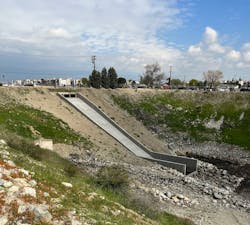The Chino Basin Water Conservation District (CBWCD) has unveiled its newly constructed concrete spillway to help the district retain up to 18 million additional gallons of stormwater runoff in its groundwater basins for future use.
The $1.05 million Montclair #2 Spillway Replacement Project was unveiled at a ribbon cutting ceremony on Jan. 19, following a series of major rainstorms. The spillway will allow the district to keep water at a higher level in Montclair Basin #1, which then percolates into the Chino Groundwater Basin, a source of drinking water for several communities.
The new spillway is a key piece of infrastructure for the Montclair Basins, a chain of four CBWCD percolation basins adjacent to the San Antonio Creek Channel. The sandy, gravelly soil can percolate 18 inches of water per day.
The spillway project was completed in October with $300,000 in assistance from the American Rescue Plan Act (ARPA) funds, awarded to CBWCD by the County of San Bernardino.
The spillway complements a planned inlet diversion project by Inland Empire Utilities Agency (IEUA) that will increase stormwater capture by an additional 96 acre-feet per year — enough to serve almost 200 families for a year.
“IEUA takes pride in our relationship with regional agencies, and we are proud to partner with the Chino Basin Water Conservation District and the Metropolitan Water District of Southern California to advance our agencies’ goals of protecting and preserving the quality of life for residents throughout the Basin,” says Marco Tule, IEUA board president. “Through this collaboration, we will be able to capture more stormwater annually for use within our region. Projects like this are essential to persevering through this unprecedented, severe drought.”
Together, the projects were funded by a $1 million grant from Metropolitan Water District of Southern California’s (MWD) Stormwater for Recharge Pilot Program.







